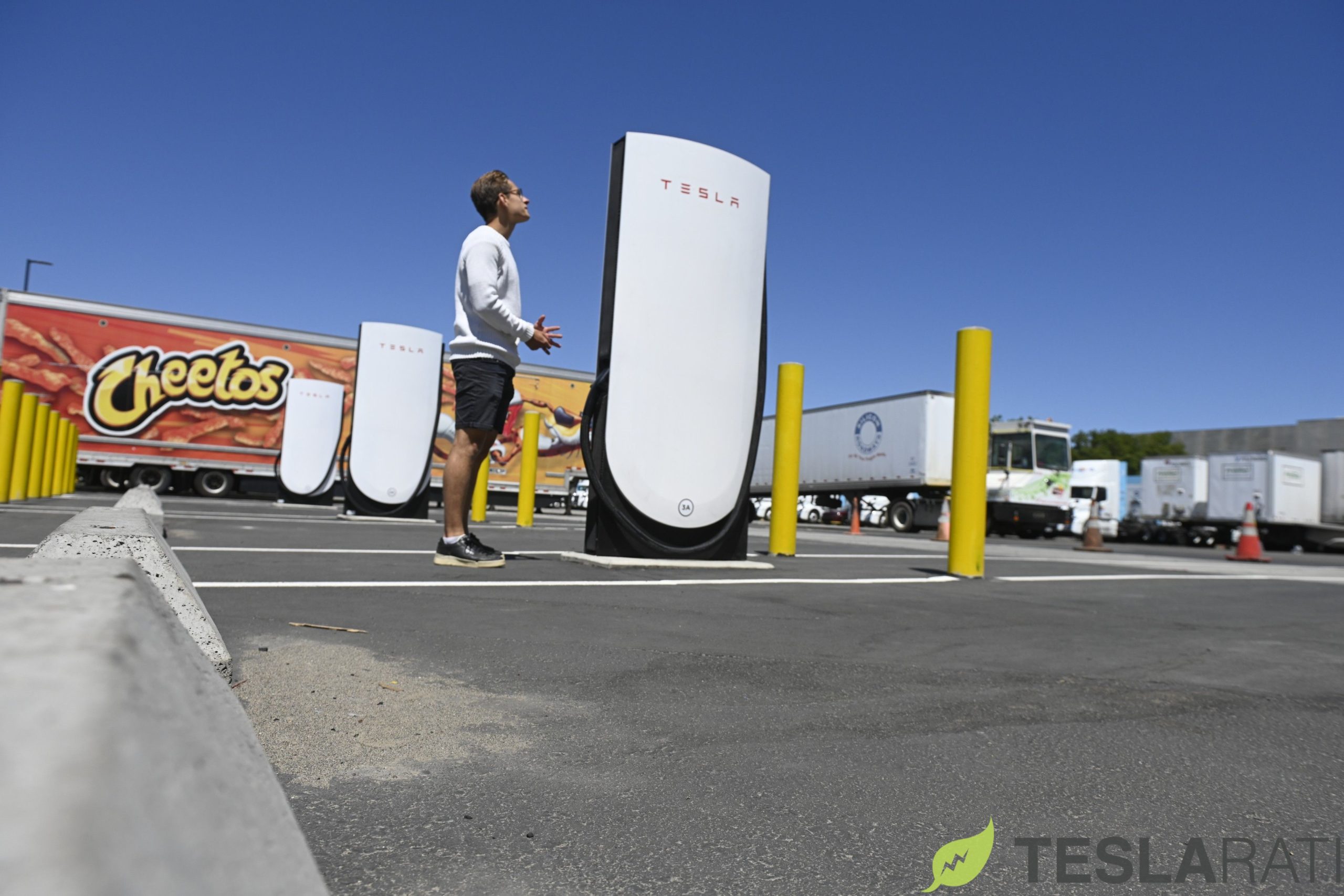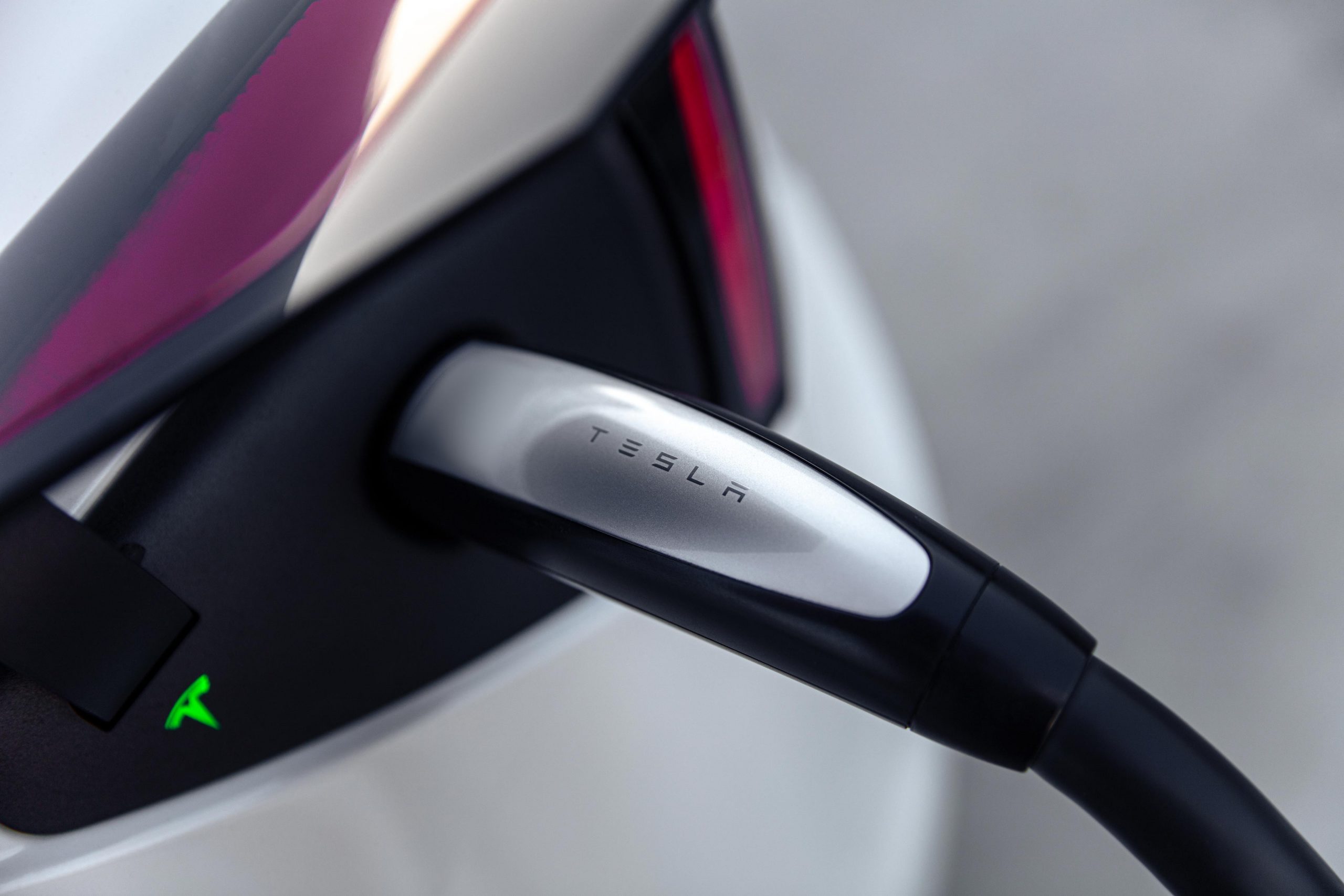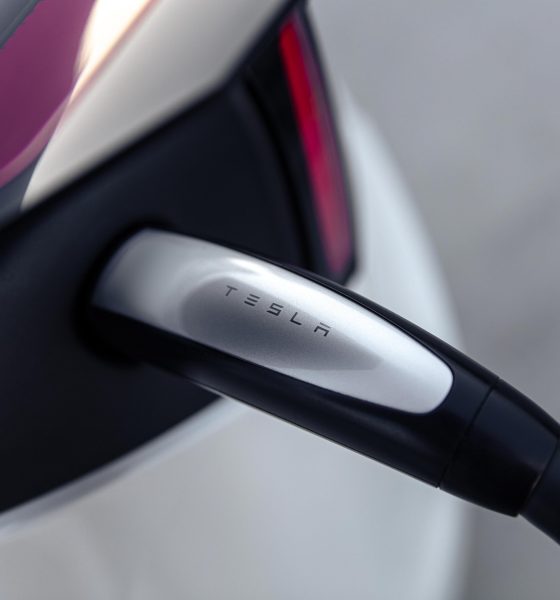Rumors about Tesla’s upcoming V4 Supercharger are swirling throughout the community, with various details about the new charging stacks being speculated against. Tesla Superchargers are the most populous on Earth and have also started to expand to other automakers in some regions, like Europe. However, the company is looking to bring out a new design and also a potential adoption of CCS support for non-Tesla owners.
Tesla’s current top-of-the-line Supercharger is the V3, which is capable of 250 kW charging speeds that can give owners 1,000 miles of range per hour. The introduction of the V3 Supercharger was during my first days as a journalist at Teslarati, and I remember it vividly. It was incredible to see such fast charging speeds and a controlled and calculated rollout of Tesla’s new tech. But of course, even new tech becomes outdated.
The new V4 Supercharger could have a completely updated design, according to @MarcoRPTesla, who stated that the new design will be taller, slimmer, and more streamlined than previous Supercharger shell designs.
As for the V4 design, it looks like Tesla will be using a different shell than the current V2 and V3 models.
While I have yet to determine the new shape, I was able to find the dimensions so that it can be compared to the current model. pic.twitter.com/QQhtDgHfCJ
— MarcoRP (@MarcoRPTesla) July 9, 2022
One could argue that the design of the upcoming V4 Superchargers are similar to the Megachargers Tesla will utilize for the Semi. Teslarati showed exclusive images of the Megacharger design at the Frito-Lay factory in Modesto in June, and it is similar to the drafts of the V4 Supercharger design.
Credit: Teslarati reader Timke Klinker
As you can see from these drafted designs, the new V4 Supercharger could be completely different in terms of dimensions and could be an advantage when used with Tesla’s upcoming Cybertruck as it is a larger vehicle.
The front page of a report also leaked from Tesla that showed the company is planning to develop a Supercharger Charge Post that has Dual Cables that are suitable for both V3 and V4 charging speeds and could also include a potential CCS charging port for third-party automakers to use.
Now, Tesla has discussed opening Superchargers to third-party companies for several years, and it’s already started in the form of a Pilot Program in Europe. The same type of program could be launched in the United States later this year, and it likely will start with the V4 Supercharger. After all, the White House said in late June:
“Later this year, Tesla will begin production of new Supercharger equipment that will enable non-Tesla EV drivers in North America to use Tesla Superchargers.”
V4 supercharger deployment starts this year, first locations will be in Austin, Texas. Higher max charge rate and voltage will be supported, as well as both CCS and Tesla cables @elonmusk $TSLA
— Whole Mars Catalog (@WholeMarsBlog) July 13, 2022
Earlier this week, automaker Aptera pleaded to Congress that Tesla’s Supercharger should be the standard in the United States. “While electric vehicle technology has rapidly advanced, the charging standard in the U.S. has not,” Aptera wrote in an email to Teslarati. “CCS and SAE J1772, the US’s common standards, are clunky, cumbersome, and expensive.”
Tesla’s non-Tesla Supercharger pilot program expands to France, Norway
It is unlikely that Tesla’s Supercharger design will be adopted as the Standard, but the inclusion of CCS-compatible charging connectors on upcoming Superchargers would be a huge advantage for e-mobility and the adoption of EVs as a whole.
I’d love to hear from you! If you have any comments, concerns, or questions, please email me at joey@teslarati.com. You can also reach me on Twitter @KlenderJoey, or if you have news tips, you can email us at tips@teslarati.com.

News
Tesla FSD fleet is nearing 7 billion total miles, including 2.5 billion city miles
As can be seen on Tesla’s official FSD webpage, vehicles equipped with the system have now navigated over 6.99 billion miles.

Tesla’s Full Self-Driving (Supervised) fleet is closing in on almost 7 billion total miles driven, as per data posted by the company on its official FSD webpage.
These figures hint at the massive scale of data fueling Tesla’s rapid FSD improvements, which have been quite notable as of late.
FSD mileage milestones
As can be seen on Tesla’s official FSD webpage, vehicles equipped with the system have now navigated over 6.99 billion miles. Tesla owner and avid FSD tester Whole Mars Catalog also shared a screenshot indicating that from the nearly 7 billion miles traveled by the FSD fleet, more than 2.5 billion miles were driven inside cities.
City miles are particularly valuable for complex urban scenarios like unprotected turns, pedestrian interactions, and traffic lights. This is also the difference-maker for FSD, as only complex solutions, such as Waymo’s self-driving taxis, operate similarly on inner-city streets. And even then, incidents such as the San Francisco blackouts have proven challenging for sensor-rich vehicles like Waymos.
Tesla’s data edge
Tesla has a number of advantages in the autonomous vehicle sector, one of which is the size of its fleet and the number of vehicles training FSD on real-world roads. Tesla’s nearly 7 billion FSD miles then allow the company to roll out updates that make its vehicles behave like they are being driven by experienced drivers, even if they are operating on their own.
So notable are Tesla’s improvements to FSD that NVIDIA Director of Robotics Jim Fan, after experiencing FSD v14, noted that the system is the first AI that passes what he described as a “Physical Turing Test.”
“Despite knowing exactly how robot learning works, I still find it magical watching the steering wheel turn by itself. First it feels surreal, next it becomes routine. Then, like the smartphone, taking it away actively hurts. This is how humanity gets rewired and glued to god-like technologies,” Fan wrote in a post on X.
News
Tesla starts showing how FSD will change lives in Europe
Local officials tested the system on narrow country roads and were impressed by FSD’s smooth, human-like driving, with some calling the service a game-changer for everyday life in areas that are far from urban centers.

Tesla has launched Europe’s first public shuttle service using Full Self-Driving (Supervised) in the rural Eifelkreis Bitburg-Prüm region of Germany, demonstrating how the technology can restore independence and mobility for people who struggle with limited transport options.
Local officials tested the system on narrow country roads and were impressed by FSD’s smooth, human-like driving, with some calling the service a game-changer for everyday life in areas that are far from urban centers.
Officials see real impact on rural residents
Arzfeld Mayor Johannes Kuhl and District Administrator Andreas Kruppert personally tested the Tesla shuttle service. This allowed them to see just how well FSD navigated winding lanes and rural roads confidently. Kruppert said, “Autonomous driving sounds like science fiction to many, but we simply see here that it works totally well in rural regions too.” Kuhl, for his part, also noted that FSD “feels like a very experienced driver.”
The pilot complements the area’s “Citizen Bus” program, which provides on-demand rides for elderly residents who can no longer drive themselves. Tesla Europe shared a video of a demonstration of the service, highlighting how FSD gives people their freedom back, even in places where public transport is not as prevalent.
What the Ministry for Economic Affairs and Transport says
Rhineland-Palatinate’s Minister Daniela Schmitt supported the project, praising the collaboration that made this “first of its kind in Europe” possible. As per the ministry, the rural rollout for the service shows FSD’s potential beyond major cities, and it delivers tangible benefits like grocery runs, doctor visits, and social connections for isolated residents.
“Reliable and flexible mobility is especially vital in rural areas. With the launch of a shuttle service using self-driving vehicles (FSD supervised) by Tesla in the Eifelkreis Bitburg-Prüm, an innovative pilot project is now getting underway that complements local community bus services. It is the first project of its kind in Europe.
“The result is a real gain for rural mobility: greater accessibility, more flexibility and tangible benefits for everyday life. A strong signal for innovation, cooperation and future-oriented mobility beyond urban centers,” the ministry wrote in a LinkedIn post.
News
Tesla China quietly posts Robotaxi-related job listing
Tesla China is currently seeking a Low Voltage Electrical Engineer to work on circuit board design for the company’s autonomous vehicles.

Tesla has posted a new job listing in Shanghai explicitly tied to its Robotaxi program, fueling speculation that the company is preparing to launch its dedicated autonomous ride-hailing service in China.
As noted in the listing, Tesla China is currently seeking a Low Voltage Electrical Engineer to work on circuit board design for the company’s autonomous vehicles.
Robotaxi-specific role
The listing, which was shared on social media platform X by industry watcher @tslaming, suggested that Tesla China is looking to fill the role urgently. The job listing itself specifically mentions that the person hired for the role will be working on the Low Voltage Hardware team, which would design the circuit boards that would serve as the nervous system of the Robotaxi.
Key tasks for the role, as indicated in the job listing, include collaboration with PCB layout, firmware, mechanical, program management, and validation teams, among other responsibilities. The role is based in Shanghai.
China Robotaxi launch
China represents a massive potential market for robotaxis, with its dense urban centers and supportive policies in select cities. Tesla has limited permission to roll out FSD in the country, though despite this, its vehicles have been hailed as among the best in the market when it comes to autonomous features. So far, at least, it appears that China supports Tesla’s FSD and Robotaxi rollout.
This was hinted at in November, when Tesla brought the Cybercab to the 8th China International Import Expo (CIIE) in Shanghai, marking the first time that the autonomous two-seater was brought to the Asia-Pacific region. The vehicle, despite not having a release date in China, received a significant amount of interest among the event’s attendees.










